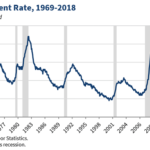4% Unemployment Makes Employee Engagement CRUCIAL
I believe we have the capability to innovate our way out of anything. The problem is, we generally don’t act until there is a crisis. When unemployment was in double figures, there was no compelling reason to pay attention to the importance of engaging employees. After all, where were they going to go? It was tough “out there” and they were unlikely to walk out the door.
Even if you’re a kind soul who truly cares about your team, there’s still a good chance you have not been giving enough attention to engaging your employees. You’re busy; you have a lot to do.
 Consider this your wake-up call. Your employees now have many options, especially your top performers. Unemployment is at 4%. Take your team for granted at your peril. There IS a crisis; time to innovate.
Consider this your wake-up call. Your employees now have many options, especially your top performers. Unemployment is at 4%. Take your team for granted at your peril. There IS a crisis; time to innovate.
At a time of year when most organizations are looking at budgets, an equally important task is to look just as closely at your employee engagement. There are numerous ways to measure it: use of employee benefits, mistakes made, customer accolades versus complaints, productivity, etc. My guess, however, is that you already know whether your employees are engaged. You can tell by the energy (or lack thereof) at your work place.
If there is one thing you can do this year to ensure growth and/or increased productivity, it is to focus on ways to engage your team more fully. Unfortunately, this is often not even on most leaders’ radar. It’s too easy to decide that it’s hopeless– people will be people – I can’t do anything about whether or not they are engaged.
How do you know? Have you even tried?
First of all, you get more of what you focus on. The moment you shift your focus from, “What’s the use?” to “Let’s see what we can make happen,” you will begin to see an uptick in engagement. Add to that some simple approaches:
- Before going straight to your work area at the beginning of your day, make an effort to greet everyone on your team. If they respond with a puzzled look and ask, “Who are you again?” you know it’s a bigger problem than you feared.
- “Catch” people doing something right.
- Say “thank you” and be specific about what you’re thanking them for.
- Write them up for doing something well versus writing them up for mistakes.
These are just a few ways to engage your employees, there are many more. Those listed above don’t take a lot of time; they do take focus.
Why not try them out? Be innovative! What have you got to lose?
“There is a principle which is a bar against all information, which is proof against all arguments, and which cannot fail to keep a man in everlasting ignorance—that principle is contempt prior to investigation.” – Herbert Spencer
Or, as the old TV slogan encouraged us, “Try it; you’ll LIKE it!”
Appreciation = “I notice”

I’ve written about this before but it bears repeating.
We seem to make a very big deal about employee engagement. We conduct surveys, put in systems and programs to address the issues and yet nothing seems to improve.
Perhaps we are overcomplicating things.
Our employees and co-workers (our families!) all want to feel appreciated. We want to fulfill those desires.
Here is a simple way to show appreciation in any situation: simply notice what others are doing and tell them you noticed.
To the receptionist: “I’ve noticed that, when things are slow for you, you ask your co-workers if there’s anything you can do for them. Thank you for that.”
To the maintenance person, “I see that not only are the floors clean but the baseboards are, as well. Not everyone takes that extra step. Thank you.”
To your boss, “Whenever you want to speak to me you always ask if it’s a good time. I really appreciate that consideration.”
Take a moment to think about those around you. What do they do, without being asked, that is noteworthy? When I say “noteworthy” I don’t mean that it has to be a big deal. It’s just something they do that makes work more pleasant.
Another way to think about it is, what do you complain about others doing? Are there people around you who DON’T do that? Have you told them how much you appreciate it? Here’s an example: when I am in a restaurant and telling a story, I really don’t like it if the server interrupts. First of all, have you noticed it’s usually when you’re in the middle of the punch line? Therefore, whenever a server waits for me or anyone else at the table to stop talking before interrupting, I always let them know how much I appreciate it.
You might say, “Well, Silver. That’s how they are SUPPOSED to behave,” and you would be correct. That doesn’t mean they don’t deserve to be thanked for it. Keep your focus on what people do that pleases you, thank them for it and engagement will naturally increase.
Change your focus; engage your team!
Using Focused Attention to Increase Employee Engagement
It’s been awhile since I have written about the numerous benefits of harnessing The Law of Attraction to produce the results you want.
The Law of Attraction dictates that you get more of what you focus on. Unfortunately, this seems much clearer on days when we are attracting what we DON’T want. Expressions like, “It’s going from bad to worse,” or “I feel like I’ve got one foot nailed to the floor and I’m going in circles,” or my personal favorite, “Could you please check my back and see if someone stuck a target on it?” are all results of attracting by accident versus by design.
I had a morning like that. I had more items on my “to do” list than time to do them and I started the day gearing up for a battle. Well, The Law of Attraction did not let me down. My printer wasn’t doing what it should (or, more specifically, what I needed RIGHT NOW) and I got frustrated and angry. So, instead of changing my focus (by now I really should know to do this), I gritted my teeth and forged ahead, determined to conquer the day. As a result, when I went to make coffee (caffeine? Oh, yeah, THAT’LL help calm me down), I spilled half of it on the counter and the other half on the floor. Back to the printer—the problem got worse. Big surprise. But did I pay attention and take 5 minutes to change my focus? You know the answer because it’s what most of us do. We focus on the problem and it grows bigger and bigger.
Once the printing was done (having taken 3X as long as it should and twice the paper), I decided to have lunch and chill out. I made myself a sandwich and then went onto YouTube to find a video from The Voice, my favorite TV show.
This never fails to shift my focus to happier thoughts. I only had to watch 10 minutes of it to feel the tension relax in me and to start paying attention to the fact that I still had half a day left to get some important things done. Now, instead of tackling them while tense, a surefire way for more things to go wrong, I was in a good mood. From past experience, I know I will have an incredibly productive day. But let’s say for a moment that I don’t. At least I’ll have a day when I’m not wrapped so tight I feel like kicking a wall. That alone is worth the 10 minutes I took to shift my focus.
Think of your employees like that pesky printer. The more you focus on what they’re NOT doing, or that they’re doing it too SLOWLY, the more you will attract their poor performance. Not only that but you will infect them with your bad mood. So now, not only do you have a team that’s not producing what you want, everyone is so darn cranky! When people are cranky, they don’t engage; they use whatever protective behavior has served them in the past—sabotaging the work, hiding, calling in sick—you get the picture.
Experiment with the following: as you move about your day, begin focusing on what each team member has done or is doing right. Take a few seconds to fully absorb it. You don’t have to say a word! Not only will your point of attraction shift from non-productive to productive but your team will become more engaged—all without you saying a word. This is the power of deliberately harnessing The Law of Attraction by focusing your attention on what you want.
Or you could just kick a wall.
Remember GIGO?
According to Wikipedia, Garbage in, garbage out (GIGO) in the field of computer science refers to the fact that computers, since they operate by logical processes, will unquestioningly process unintended, even nonsensical, input data (“garbage in”) and produce undesired, often nonsensical, output (“garbage out”).
My definition
I have co-opted GIGO to mean that, if you feed your mind garbage, then your mind will produce undesirable thoughts. Since the Law of Attraction dictates, “You get more of what you focus on,” then feeding your mind garbage results in a garbage-filled life.
Be Careful What You Feed Your Mind
If you want to know the biggest Influencer in your life, the answer would be, “Your mind.” Your mind is with you 24/7 and influences every aspect of how you experience life. When you sleep it influences your dreams.
Western society spends an unreasonable amount of time obsessing about what we eat. Is it too much or too little? Is it good for me or bad for me? One of the fastest ways to make a lot of money is to create a book or video or class that promises a beautiful body while you eat whatever you want.
What we don’t pay nearly enough attention to is what we feed our minds. Oh, we have lots of opinions about what children should be feeding their minds. We know that small, impressionable minds shouldn’t be exposed to violent films or TV shows. We are horrified when parents of teens allow them to play violent video games.
All of the above falls under the category of what our parents said to us that we hated: do as I say, not as I do.
This Really Matters
I am in recovery from a major depression that lasted for 30 years. I can tell you without equivocation that what you feed your mind makes a huge difference in the quality of your life. Since your mind is your constant Influencer, it is imperative that you give it material that will help rather than hurt you. Paying attention to what I focused on was the beginning of my recovery from depression.
Your Mind Doesn’t Know the Difference Between Pretend & Reality
I will never forget the day this was driven home to me with a 2X4 (metaphorically, not literally—a 2X4 would hurt!). I was in a really foul mood. A foul mood is so much worse than a bad mood. It is—well—FOUL. Since I had begun to really pay attention to cause-and-effect in my life, I was confused. I couldn’t pinpoint any reason for feeling so dark. There was nothing going on at the time that would explain it.
And then it hit me! While on the elliptical trainer at the gym I had been listening to books on tape. At the time I was listening to a James Patterson novel. I can’t recall the title but I DO recall it had a lot of graphic violence. Since my brain (like yours) doesn’t know the difference between pretend and reality, at some level my mind thought it was happening to me. The foul mood was the reptilian part of my brain signaling me that I was in imminent danger.
Since that day I am careful about what “entertainment” I choose. Friends who don’t necessarily subscribe to my opinion on this but honor my choices will call and say, “Don’t go see this movie, you will hate it.” I walk out of movies that make me uncomfortable (and ask for a refund) and have been known to throw a book or two across the room when the ending was far from happy. There are authors I will never read again, even though (or maybe because) they are great writers.
Nutritious Food for the Mind
We live in a wonderful time when information is as close as our computers. There are numerous websites, videos, blogs, podcasts and online articles that can inspire and uplift. There are books, movies and TV shows that can do the same. The more we feed our minds a nutritious diet, the less stressed we will be and the more we attract what we want.
In the work we do (paid or not), why not focus on the positive aspects of what we’re doing? What if we celebrated each step of progress? What if we allowed ourselves to feel the thrill of a job well done? Imagine the quality of your life if your mind, your biggest influencer, was consistently applauding your efforts.
Question: Are you careful about the diet you are feeding your mind? Do you remember a time when you realized your mind was being negatively influenced? What prompted you to start paying attention to this? I am gathering these kinds of stories and would love to hear about your experience.
For private coaching, or information on having Silver work with your company on employee engagement, call 877-840-5416 or email: Info@SilverSpeaks.com
Feedback that doesn’t hurt
One way we influence others is through feedback. Feedback can be an effective tool for getting others to repeat behavior that pleases you. Some feedback is as simple as saying, “Thank you,” with a smile. At a restaurant you tell the server, “I really appreciate your keeping my water glass full.” You tell a co-worker, “I really like it when you ask me if I have time to talk instead of immediately launching into a conversation. I wish everyone would do that.”
Let me share with you a feedback tool I learned many years ago that is AMAZING in terms of being able to provide feedback without it being heard as criticism. The acronym for it is LBNT which stands for “like best/next time.” Here’s how it works:
We’ll start with leaders but keep reading if you’re not a manager. There are opportunities for you to use this tool, as well.
Let’s say a staff member (we’ll call her Lupe) turned in a project to you and you’ve had a chance to review it. You set up a meeting with Lupe to review the results. If you’re like most, you start by telling her what you liked about her work. By the say, employees refer to this tactic as “being buttered up for the kill.” That’s because they know what’s coming next—a stinging (at least to their ears) critique of all the things that weren’t done well. Both you and Lupe walk away from this meeting dispirited. It wasn’t easy for you to tell her these things and it wasn’t easy for her to hear them.
LBNT is a tool that sets up a very different scenario. In the review meeting, you start by asking Lupe, “What did you like best about your work on this project?” She might answer, “I was proud of turning it in a week early.” This is great because, truth be told, you didn’t even notice that she’d turned it in early and now that you know, you can tell her how much you appreciate it (without, of course, mentioning that you didn’t even notice). You keep probing, “What else?” until she’s given you a picture of what she liked best about her performance. Then you ask, “What, if anything, would you do differently next time?” This is an opportunity for Lupe to “tell on herself.” Maybe she says, “I thought I could have researched the data on page 12 more thoroughly.” Without commenting, you continue to ask, “What else?” until she has given you HER OWN CRITIQUE of the project.
Here’s what’s so great about this. Lupe is doing her own performance evaluation! It is much kinder to allow her to do this herself versus hearing it from you. Additionally, you will gain valuable information: (1) details about the work that you didn’t notice; and (2) insight into the way Lupe thinks and works. This kind of feedback is an essential leadership skill.
Now it’s YOUR turn. You tell her what you liked best and what you would like to see next time. What you DON’T have to do is point out the issues Lupe already revealed in her own evaluation. If appropriate, you might comment on them and let her know if you agree or disagree. Maybe Lupe was too easy or too hard on herself. That would certainly be valuable feedback to give.
LBNT gives both parties a voice and a voice is what we all want.
What if you’re not a manager and wouldn’t have an opportunity for the scenario above? There are many opportunities to use LBNT—when family members do chores at home, for example. It wouldn’t be as formal as the meeting with Lupe—that would be weird—but it still works. Let’s say your son Malcolm cleaned his room after using up every excuse he had for NOT doing it. Here’s how the conversation after he’s done might go:
You: What did you like best about doing that?
Malcolm: Not a thing.
You: Well, if you DID like something about it, what would it be?
Malcolm: I found my iPod.
You: Great! What else?
Malcolm: I don’t know. I guess I like that I can see where things are now.
You: Okay, what will you do differently from now on?
Malcolm: Maybe keep it cleaner so it doesn’t get so bad.
You: Anything else?
Malcolm: Sheesh! Isn’t that enough?
You: Okay, what I liked best is that you did it without moaning the whole time. Finding that iPod was a blessing; once you put those ear buds in, you seemed to work faster. Also, I appreciate your going the extra step by carrying your hamper to the laundry room. And I agree with you. If you keep it cleaner as you go, you won’t have such a mess to clean up next time. I’m proud of you, son.
Note: I’ve outlined just two scenarios here–one to improve leadership skills and one for parenting skills. Use them as a model for how to do this in your own life. I’d love to hear back from you when you do.
P.S. You have my permission to anonymously slip this into your boss’ In Box. LOL.



